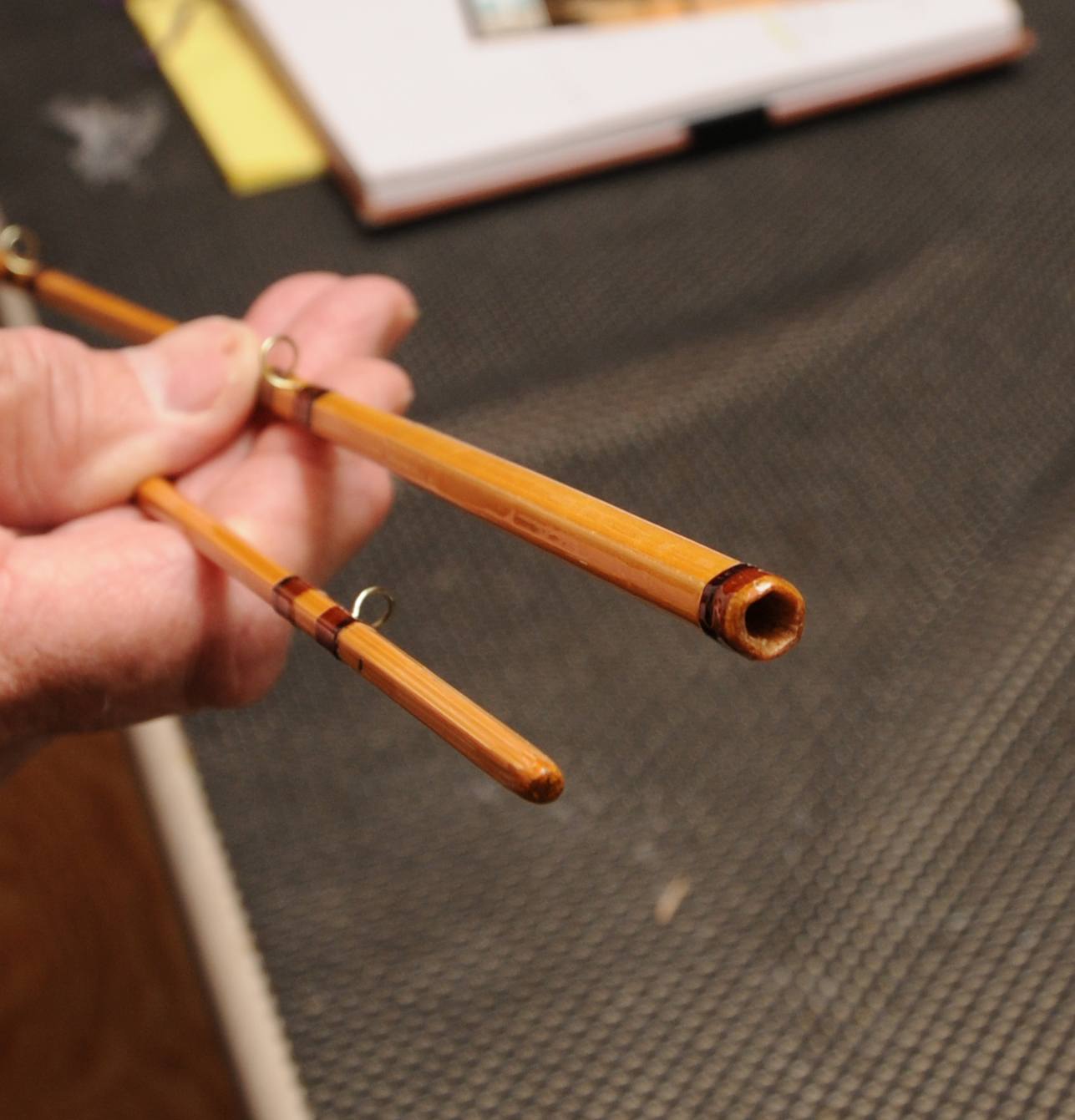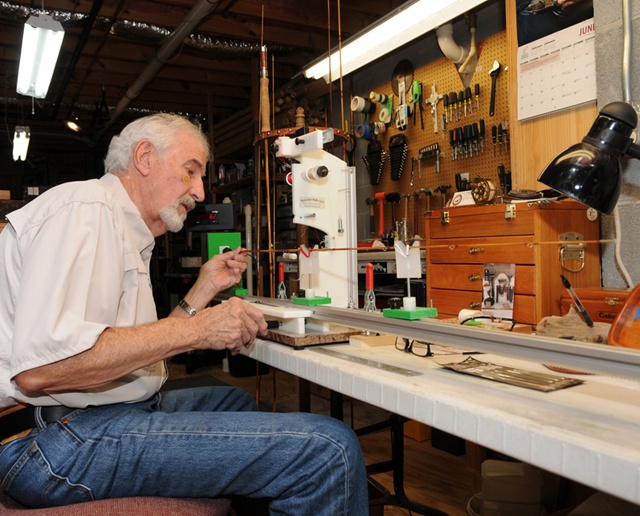


Fly Fishing
20 September 2017
Along with my penchant for classic American side-by-sides, I’m a fan of bamboo fly rods. They fit my casting style—slow and easy. So when a neighbor appeared at the door selling chances—six for $25—on a custom 7½-foot, 4-weight bamboo rod to raise money for a certain conservation organization, I thought, Why not? and handed him a five-spot and 20. Little did I know just how expensive that rod would prove to be.
We’d recently moved to Upperville, Virginia, from Winona, Minnesota, where I’d been hoodwinked into editing the newsletter of the organization’s local chapter. When new to that lovely town 125 miles down the Mississippi from the Twin Cities, I’d innocently asked a local fly flinger where to fish for trout.
“Yeah, sure, I’ll be glad to show you,” he said, all Minnesota nice. But then came the quid pro quo. “You’re a writer, right?” he asked, all innocence. “You can do our newsletter.”
Having suffered through a couple of years of missed deadlines, I was loath to having any more to do with the group, lest editing another newsletter were to fall on my head. Still, I was willing to support conservation, so I sprang for the chances on the bamboo rod and, miracle of miracles, won it. Turned out maker Hank Woolman’s wife, Marcia, was president of the organization’s local chapter. She, no shrinking violet at all, immediately pounced: “You’re a writer, right? You have to do our newsletter!” Her not-so-velvet leash roped me into becoming council chair. Had I known then how much that
Turned out maker Hank Woolman’s wife, Marcia, was president of the organization’s local chapter. She, no shrinking violet at all, immediately pounced: “You’re a writer, right? You have to do our newsletter!” Her not-so-velvet leash roped me into becoming council chair. Had I known then how much that rod would cost me, I would have been hundreds of bucks ahead to have bought it straight out. So much for the backstory. In the process, Marcia, Hank, and I became great friends. Hank is self-effacing, quick with
So much for the backstory. In the process, Marcia, Hank, and I became great friends. Hank is self-effacing, quick with smile and gracious word, and a silo of knowledge, which he’s willing to share, but only if asked. Excellent huntsman and master of the hounds, he personifies all the best of a classic Virginia gentleman. Superb angler, his fly rods are exquisite, a feat more amazing because his right wrist ends in a stump where his hand, lost in a farming accident, used to be.
Six- and seven-piece graphite travel rods are common these days, but try to find one of bamboo. Upon receipt of an advance for a new book, I asked Hank to make me one. He produced a six-piece, 6-weight marvel. The challenge, he confided, was finding just the right German silver ferrules that would not inhibit the way the rod flexed.
Even he was surprised by how well this unusual rod cast. I was ecstatic. I fished the rod for Arctic char in Labrador, and it worked flawlessly.
Then I took a dumb pill, something I do with regularity. Wanting to add witness marks so I could more rapidly align the rod’s sections, I used a sharp center punch to tap little dimples into the top and bottom of each set of ferrules. That bent them. First, I couldn’t pull the sections apart, and when I finally was able to, I couldn’t push them back together again.
I was too embarrassed to tell Hank—it would have tried his patience. So I set the rod in the corner, hoping that one day I’d find a bamboo rod maker who could correct my stupidity.

Bamboo ferrules helped correct the author’s ill-conceived “marking” attempt.
Enter Lou Dondero of Hendersonville, North Carolina. I recently asked fly shops near my home in Asheville who might be able to replace a guide on an Orvis impregnated bamboo 6-weight. A string of referrals led me to Lou. His rods are beautiful, but when we spoke by phone, he allowed as to how repairing old bamboo rods held more fascination for him than building new ones.
Lou invited me to visit his shop. Compared to Hank’s, his looks like an operating room. His jig for planning cane wears the patina of deeply cared-for silver. He showed me the glistening machine he uses to wind guides, sample wrappings he’s made so he could perfectly match the color of originals, and how he’s adapted a rotisserie motor from a barbecue grill to gently and progressively lift blanks from his finish dipping tank.
He approaches repairing a rod like a doctor would a patient. What happened to the rod? he asks. Does the rod need orthopedic (bamboo repair or replacement of missing parts) or cosmetic surgery? How was the rod made? What were the maker’s intentions? Does the owner want to restore the rod to its original condition or simply make it fishable.
On this point Lou is firm: Classic cane rods, even the rarest Dickerson or Garrison priced in the $4,500 range, deserve to be fished. So, too, do inexpensive rods like a $50 Montague or South Bend found on eBay. For Lou, repairing a Payne or a Wes Jordan rod is fun “’cause now I’m dealing with something that a master builder did, and I’m studying why did he do this and how.”
To know how to repair bamboo rods, you have to know how to build them, Lou insists. His custom rods bring between $1,000 and $4,000. Then he laughs. As much as he enjoys the challenge of constructing an ultra-lightweight hollow model or one with bamboo ferrules, there’s a much larger market, he says, for repairing vintage rods.
“I get a lot of people who inherit a rod or are given one because they’re the only one in the family who fishes.”
Is repairing a rod worth the money? His base rate is $250 dollars a day.
“That’s a ten-hour day, and I can get a lot done. If I do have to run over into the next day, that’s another $100.” Parts—ferrules, reel seats, and guides—are extra.
“I’ll have people ask: ‘Oh man, that’s all you’re charging me?’ Others will tell me, ‘Well, I can buy a rod for $70 bucks. Why would I spend $250 to have this thing fixed?’ I tell ’em it’s going to fish like bamboo.”
Nothing, not graphite or fiberglass, fishes with the finesse of bamboo. If that isn’t enough, Lou will remind them that repairing a rod usually increases its value. Generally speaking, his repairs are almost indistinguishable from the way the rod came out of the factory.
So it is with the Orvis 6-weight he fixed for me. The guide he replaced and its wrappings, in color matching color and down to the precise number of turns, are impossible to tell from the original. Not only that, but he researched the rod’s history. According to the serial number, it was finished on August 10, 1978. The maker was Ron White, Wes Jordan’s protégé. When I fish it, I feel like I’m fishing a bit of history.
Of Hank Woolman’s six-piece 6-weight, Lou was effusive about the quality of its craftsmanship. It was the first cane rod made expressly for airline travel that he’d ever seen. He was amazed at how evenly the rod flexed throughout its length despite the number of ferrules.

Lou Dondero wrapping the guides onto the author’s Orvis rod.
To ensure the sections always fit tightly together, he admonished me to pull the ferrules directly apart and never, ever twist them. They should never be lubricated, either, not even by rolling the male in the cleft between nose and cheek as old timers tell you. And they should be cleaned occasionally with a soft cloth dampened in denatured alcohol. Like horses, rods should never be worked hard and put up wet.
The weekend after picking up the six-piece 6-weight, I exercised it on the Watauga tailwater just across the North Carolina line and downstream from Elizabethton, Tennessee. I was reminded how beautifully it laid out a weight-forward floating line and how it played a pair of wild rainbows taken on a brace of #18 bead-head nymphs fished deep with a couple tiny split shot beneath a strike indicator.
Since I prefer dries, I switched to that 4-weight Woolman cane rod I won in the raffle 20 years ago. A couple of ’bows took my #16 sulphur, and the rod handled them with consummate aplomb. In both cases, fishing Hank’s rods was like fishing with him again after so many years. And it always will be.
Craftsmen who can mend injured cane rods are few and very far between. For more information about Lou Dendero and his rod building and repair, check out ontherisebamboorods.com.
Credit: John Ross, Sporting Classics Daily.
Want to ask a question about Poronui, personalise your vacation with bespoke itinerary options or find out about available dates?
Simply fill in your name and contact email address with a short message and we will get back to you.